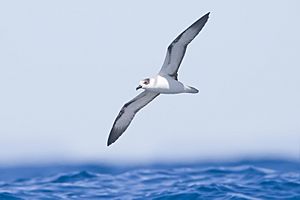White-necked petrel facts for kids
Quick facts for kids White-necked petrel |
|
|---|---|
 |
|
| Conservation status | |
| Scientific classification | |
| Genus: |
Pterodroma
|
| Species: |
cervicalis
|
| Synonyms | |
|
|
The white-necked petrel (Pterodroma cervicalis), also known as the white-naped petrel, is a type of seabird. It belongs to the Procellariidae family. These birds spend most of their lives flying over the Pacific Ocean. They are known to breed only on Macauley Island in New Zealand and on Norfolk Island and Phillip Island in Australia. They used to breed on Raoul Island but are no longer found there. The IUCN lists the white-necked petrel as a vulnerable animal. This means they need our help to survive.
Contents
What Does a White-Necked Petrel Look Like?
The white-necked petrel looks a lot like another bird called the Vanuatu petrel. However, the white-necked petrel is a bit bigger. It is about 43 centimeters (17 inches) long. Its wings can spread out to 95 to 105 centimeters (37 to 41 inches) wide. It usually weighs between 380 and 545 grams (13 to 19 ounces).
This bird has a black cap on its head. Its neck in the back is white. Its back, wings, and tail are dark grey. The area near its tail, called the rump, is a darker shade of grey. The underside of its body is white. The feathers on its wings that are used for flying have dark bases. When the birds get older or their feathers are worn, their upper parts can look even darker. It can be very hard to tell the white-necked petrel apart from the Vanuatu petrel when they are flying over the sea.
Where Do White-Necked Petrels Live and Eat?
The white-necked petrel is a solitary bird. This means it usually flies alone over the open waters of the southwest Pacific Ocean. It is a type of gadfly petrel, known for its quick and agile flight. These birds fly with little effort and few wing beats. They do not follow ships like some other seabirds do.
White-necked petrels find their food while flying. They pick up small fish and squid from near the surface of the water. Their natural habitats include subtropical or tropical lowland grassland areas where they breed. They also need large open sea areas for finding food.
Why Are White-Necked Petrels in Danger?
The biggest threat to the white-necked petrel is habitat loss. This happens on the islands where they go to lay their eggs and raise their young. When their breeding grounds are damaged or disappear, it becomes harder for them to have baby birds. Protecting these special islands is very important for the future of the white-necked petrel.
See also
 In Spanish: Fardela de cuello blanco para niños
In Spanish: Fardela de cuello blanco para niños




